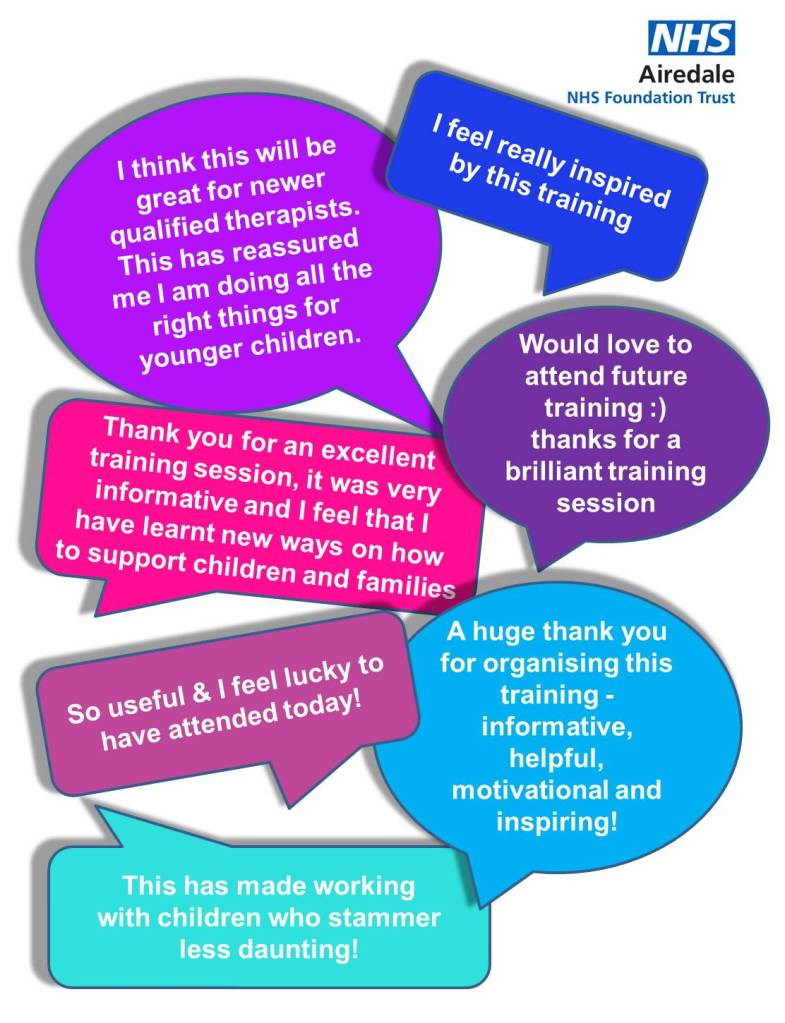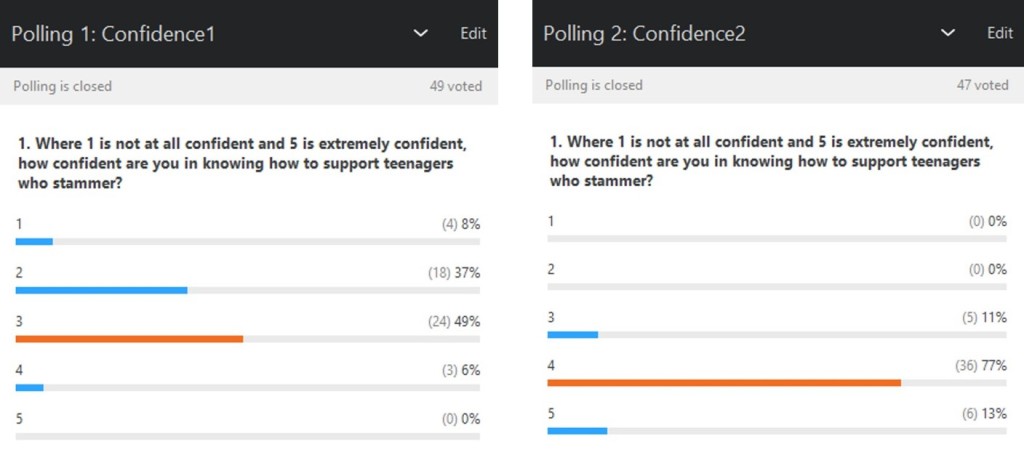
HCPC standard of performance and ethics states, “You must work in partnership with colleagues, sharing your skills, knowledge and experience where appropriate, for the benefit of service users and carers.” We are delighted to share our experience of diversifying into clinical training and hope that our learning can benefit SLTs working in other areas. With thanks to Ayesha Bibi, Leeds Beckett University SLT student, who helped to collate the data, and to all our course participants for generously sharing their feedback.
Many SLTs enter the profession with little or no placement experience in stammering. An informal audit by our department showed that about 10% of paediatric referrals are stammering-related, and yet even experienced SLTs may lack confidence in this area.
Cuts to services have meant that in many areas specialist stammering therapists have left and not been replaced. Reductions to training budgets have also made it increasingly difficult for therapists to access high-quality training. As a result, there is an inequity in services for people who stammer, which has been exacerbated by the pandemic. We know of families who have waited over a year for any kind of support and other areas where no support is available at all.
Within our specialist stammering service, we have many years’ experience in delivering services digitally. We decided to apply this experience to offering accessible and affordable online training to SLTs. Our aim was to increase the confidence of SLTs and develop their skills, enabling other NHS Trusts to standardise their dysfluency service. We hoped this would help to address the variance in service quality across regions.

Adopting a PDSA (Plan, Do, Study, Act) model, in October 2020 we piloted a free half day course for NHS SLTs – Introduction to Working with Children who Stammer. We chose to use Zoom for its reliability, ease of use and features such as break out rooms, screen sharing and instant polling. 280 SLTs from every region of the UK applied. The first 100 applicants attended free of charge, and we then repeated the course twice more with a small charge to cover our costs. Following the initial free course, we asked attendees, “If there had been a charge for the course, what difference would that have made?”
- My Trust would have paid
- I would have paid (what is the maximum you would be willing to pay?)
- I would not have attended
Only a third of respondents said their Trust might have paid, and a third said they would not have been able to attend. The average amount SLTs were prepared to pay themselves was £20-£25. Although we would have liked to continue to offer the training free of charge, that was sadly not possible. We calculated that for £20 per person, we could cover the costs of running future courses. We also decided to offer the training to final year SLT students at a cost of £10 and to open it up to independent (non-NHS) therapists at a comparable rate to that charged by other training providers.
We received 223 responses to our post-course evaluation, which we administered and collated using Survey Monkey.

“Dysfluency CPD in my Trust has been pretty much non-existent. This is the training I’ve been asking for! Thank you.”
“I’m leaving this session feeling so much more confident about my work with families, which I feel will help me be a better therapist.”
“A great mix of reassurance / fresh ideas and discussion – for the first time in a long time it has reminded me that I do actually love my job and am a good SLT! That is huge.”
“It’s really had a huge impact on my practise.”
97% of respondents agreed with the statement, “As a result of the training, I feel more confident in working with children who stammer.” At the beginning and end of each of our courses, we conduct an instant poll around levels of confidence. Participants’ confidence levels have always increased by the end.

We worked collaboratively with service-users, inviting people who stammer and parents of children who stammer to contribute to our courses. This aspect of the training is one of the most valued by attendees.
“It was amazing to hear parents’ stories as well as it opened up the side of the speech and language experience that we often don’t ever see or hear about.”
“Brilliant presentations from parents – not often you can have such an open discussion with people that have already been/going through the same journey as the family we encounter at work.”
We asked participants how they felt online training compares to face to face training.
“It was excellent – the breakout rooms are really effective and it still felt like a cohesive group who were happy to share and discuss. The management of the technology was outstanding – everything worked smoothly.”

All respondents felt online worked just as well as if not better than face to face training, citing advantages such as comfort, accessibility, affordability, no travel time or expense, easier for childcare, less time out of clinic. Many participants said they would not have been able to attend had it been face to face. The main disadvantage cited was the lack of interaction and networking opportunities, although most people felt the breakout rooms helped to address this and give some time for discussion.
Several months later, we asked participants, “What are you doing differently as a result of the training?” Common themes included use of language, incorporating the social model and acceptance of stammering, the importance of supporting parents and teachers, and knowing where to signpost.

“I’ve changed the way I talk about stammering with parents. I have changed the way I talk about the communication chain. I’ve changed my approach to taking a case history.”
“I am very much thinking about the language that I use with parents. I have been more aware of trying to think about how parents must be feeling and the importance of not rushing to give them all the facts, but walking with them through the journey of acceptance and responding to how they are thinking and feeling at that time.”
“Really thinking about reducing parental anxieties. Not assuming that teachers know about stammering. Being flexible is key and family-centred I think, but care pathways don’t always allow this so it is thinking about care pathways and what is really beneficial.”
“Practise has changed – aim of therapy is now for the stammer to never be a problem for the child / young person and that whilst therapy at a young age (if deemed necessary) may reduce stammering, it is all about making stammering ‘easier’.”
“Since my colleague and I attended the ‘Introduction….’ refresher course, we have revised/improved our Dysfluency Pathway, and from next year this will include an annual 5-session summer course for children and parents, that can be accessed year on year if required.”
41 out of 44 SLT students who attended the course agreed with the statement: “The training has increased my interest in wanting to work with children who stammer.”
Hanka, SLT student from City University, told us,
“The workshops added a great value and insight to the stammering module that I participated in as a part of the Uni course. It allowed me to extend my knowledge from the lectures by learning about real experiences of children who stammer and their parents and teachers.”
We have provided follow-up individual and group clinical supervision sessions, during which we’ve discussed management of tricky cases and issues such as working with anxious parents and educating teachers.

Lowri, SLT from South Wales, told us,
“At a time when I felt isolated working within dysfluency, clinical supervision was limited and the training budget was reduced, these very reasonably priced training sessions were priceless! The clinical supervision sessions and training have truly been ‘life changing’ for me. At 46 for the first time in my life I feel like a great therapist, with sound theoretical knowledge. I now have a plan on how to move forward with my own complex cases with additional strategies and knowledge on how to approach others which may come my way. I feel empowered, reassured and confident to provide a specialist service for pupils who stammer.”

Building on our learning, we have continuously improved the content and technical delivery of our training offer. As a result of feedback about what further training would be useful, we developed several follow-up courses, including working with teenagers and adults who stammer.
15 months after first trialling our online training, approximately 550 SLTs and SLT students from every region of the UK have attended a training or supervision event. We now have an annual timetable of courses and are also providing bespoke training to whole teams.

Feedback following each course has been overwhelmingly positive, and we now have robust evidence that this online training is helping to increase the confidence of SLTs working with people who stammer and improve their practice.
“an excellent way of sharing knowledge and helping professionals to feel enthusiastic and more competent in this area.”
Key Learning Points
High-quality training can be successfully delivered online.
Follow-up supervision can help to embed the learning.
Learning from this initiative is easily transferable. The same model could be adopted by specialist SLTs with expertise in other areas to upskill our current and future workforce, helping to reduce postcode lotteries and improve the lives of the populations we serve.
We welcome feedback and comments. Please get in touch if you would like to discuss any of the above.
Steph Burgess, Clinical Lead for Dysfluency, Airedale NHS Foundation Trust airedale.stammeringtherapy@nhs.net
